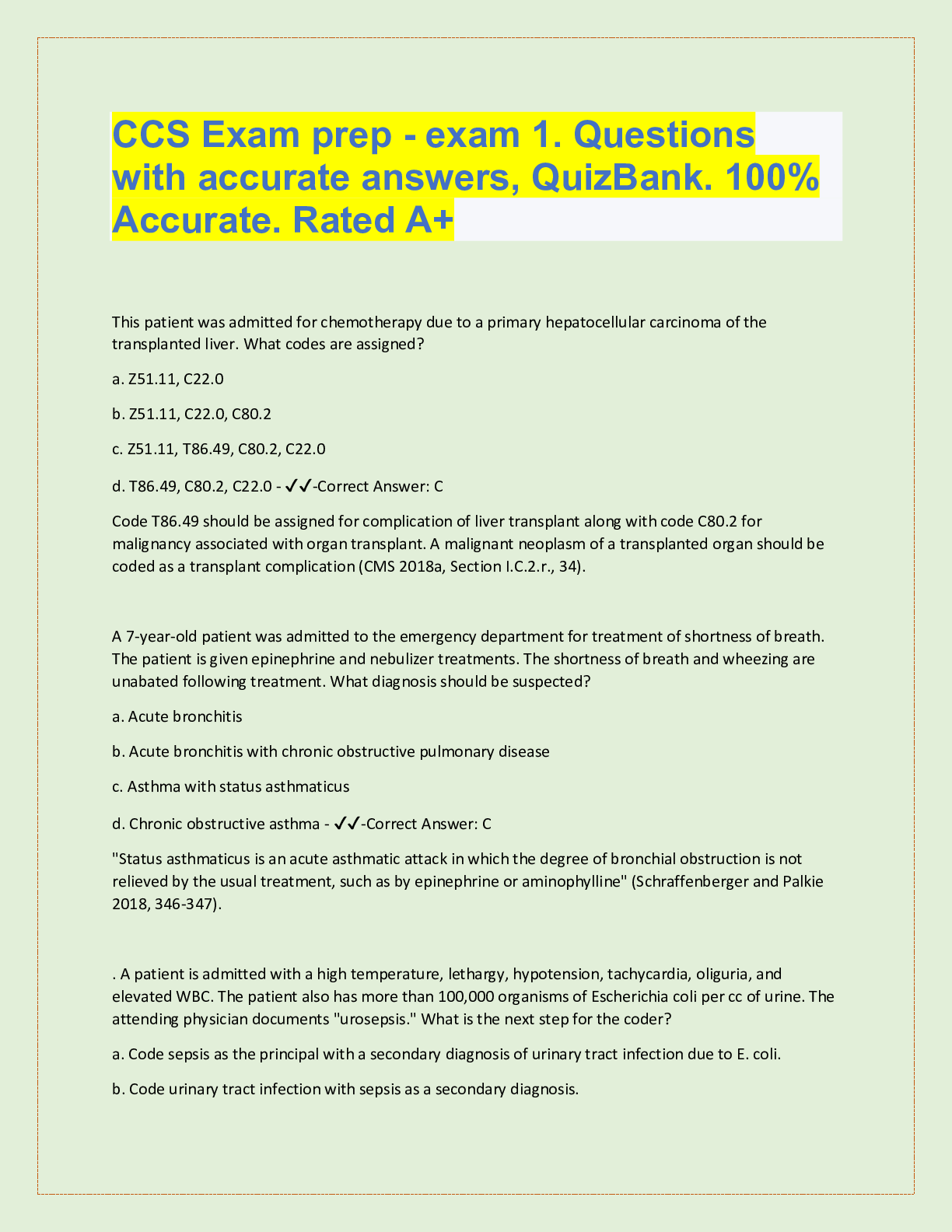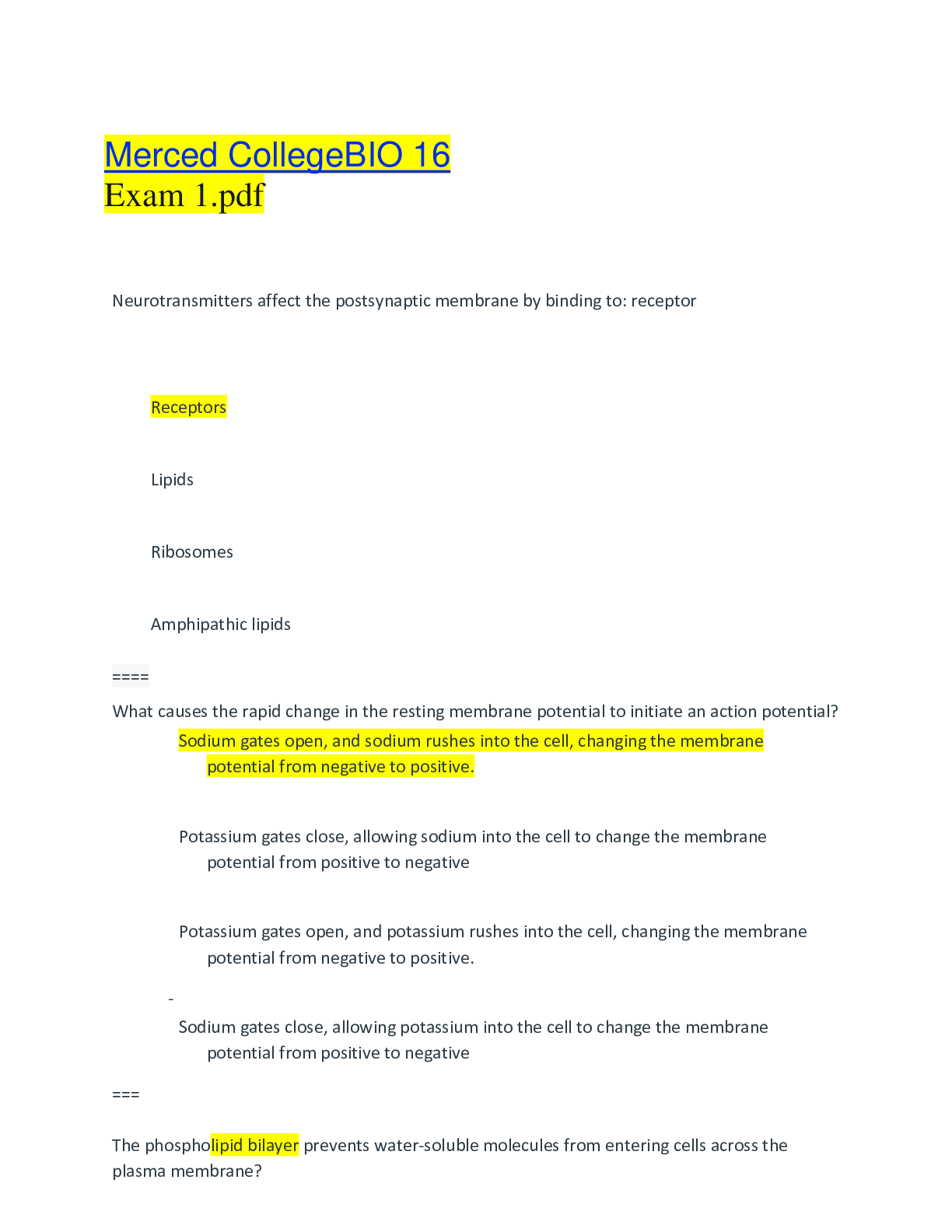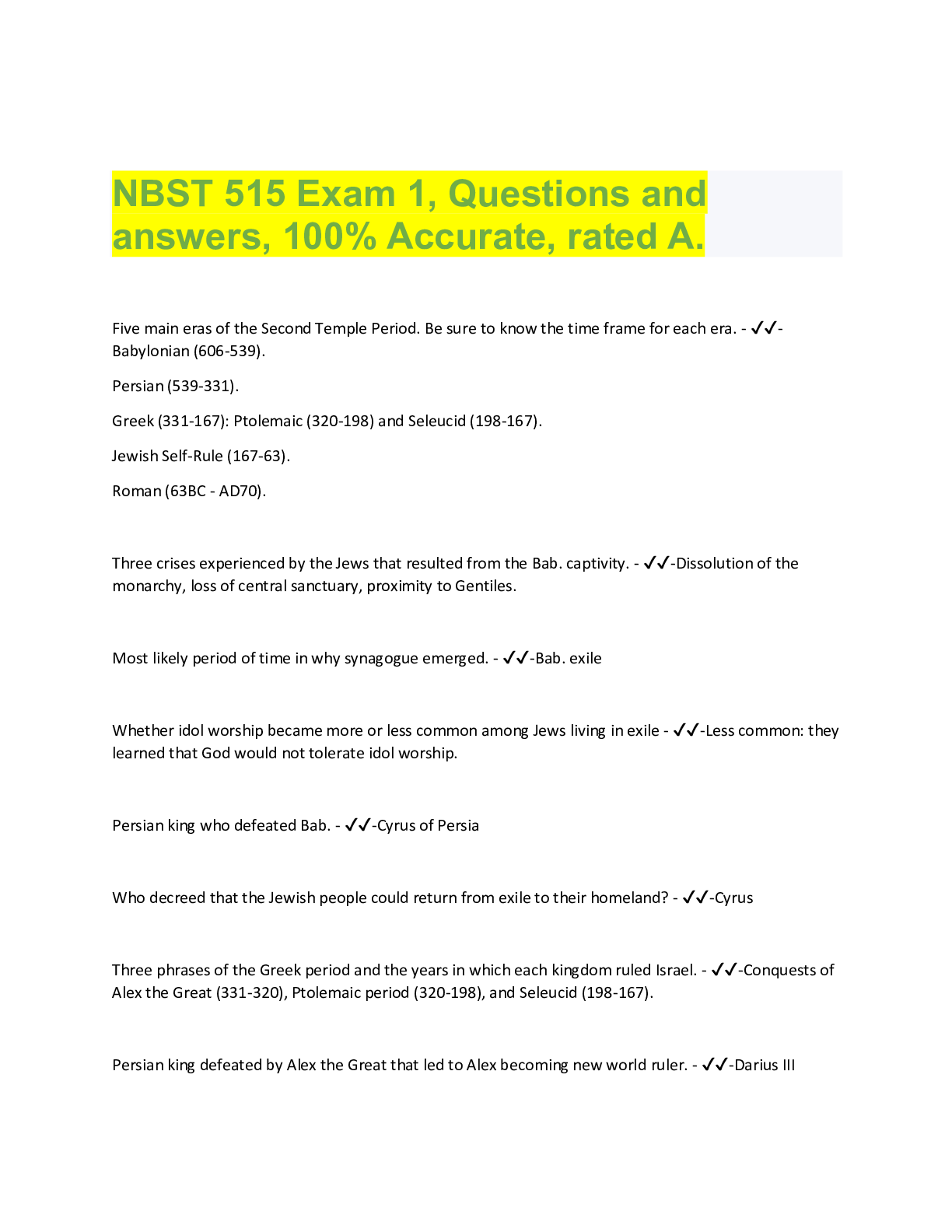Pharmacology > EXAM > Pharm II - Exam 1 REVIEW (Spring 2021). All Modules 1-5. (All)
Pharm II - Exam 1 REVIEW (Spring 2021). All Modules 1-5.
Document Content and Description Below
Module 1 4, 6, 7, 8, 10, 11, 15, 16, 17, 18, 20, 1. A nurse is providing discharge teaching for a client who has pulmonary edema and is about to start taking furosemide. Which of the following ins... tructions should the nurse include? A. Take aspirin if headaches develop. B. Eat foods that contain plenty of potassium. C. Expect some swelling in the hands and feet. D. Take the medication at bedtime. 2. A nurse is caring for a client whose serum potassium level is 5.3 mEq/L. Which of the following scheduled medications should the nurse plan to administer? A. Lisinopril B. Digoxin C. Furosemide D. Potassium iodide 3. A nurse is providing teaching to a client who has renal failure and an elevated phosphorous level. The provider instructed the client to take aluminum hydroxide 300 mg PO three times daily. For which of the following adverse effects should the nurse inform the client? A. Constipation C. Headache D. Muscle spasms 4. A nurse is providing dietary teaching for a client who takes furosemide. The nurse should recommend which of the following foods as the best source of potassium? A. Bananas B. Cooked carrots C. Cheddar cheese D. 2% milk 5. A nurse is caring for a client who has a prescription for potassium chloride (KCL) 20 mEq PO daily. The nurse reviews the client's most recent laboratory results and finds the client's potassium level is 5.2 mEq/L. Which of the following actions should the nurse take? A. Give the ordered KCL as prescribed.B. Omit the KCL dose and document it was not given. C. Call the prescribing physician and inform her of the client's serum potassium level results. D. Call the lab to verify the client's results. 6. A nurse is providing teaching for a client who is on diuretic therapy and has a new prescription for potassium chloride (KCL) 20 mEq extended-release PO daily. Which of the following instructions should the nurse provide about the new prescription? A. Take the extended-release tablets on an empty stomach. B. Add an antacid if the medication causes indigestion. C. Take the extended-release tablets whole. D. Expect urinary output to decrease while on this medication. 7. A nurse is completing a medication history for a client who reports using overthe-counter calcium carbonate antacid. Which of the following recommendations should the nurse make about taking this medication? A. Decrease bulk in the diet to counteract the adverse effect of diarrhea. B. Take the medication with dairy products to increase absorption. C. Reduce sodium intake. D. Drink a glass of water after taking the medication. 8. A nurse is providing teaching to a client who has asthma and a new prescription for inhaled beclomethasone. Which of the following instructions should the nurse provide? A. Check the pulse after medication administration. B. Take the medication with meals C. Rinse the mouth after administration. D. Limit caffeine intake 9. A nurse is caring for a client who has poison ivy and is prescribed diphenhydramine. Which of the following instructions should the nurse give regarding the adverse effect of dry mouth associated with diphenhydramine? A. "Administer the medication with food." B. "Chew on sugarless gum or suck on hard, sour candies." C. "Place a humidifier at your bedside every evening." D. "Discontinue the medication and notify your provider." 10. A nurse is preparing to administer dextrose 5% in water (D5W) 150 mL IVto infuse over 3 hr. The drop factor of the manual IV tubing is 10 gtt/mL. The nurse should set the manual IV infusion to deliver how many gtt/min? (Round the answer to the nearest whole number. Use a leading zero if it applies. Do not use a trailing zero.) 8 gtt/min 11. A nurse is preparing to administer potassium chloride 20 mEq suspension PO daily. The amount available is potassium chloride suspension 10 mEq/mL. How many mL should the nurse administer? 2 mL Module 2 3, 9,12, 13, 14, 19 12. A nurse is assessing a client who is receiving dopamine IV to treat left ventricular failure. Which of the following findings should indicate to the nurse that the medication is having a therapeutic effect? A. Systolic blood pressure is increased B. Cardiac output is reduced C. Apical heart rate is increased D. Urine output is reduced 13. A nurse is teaching a client who has been taking prednisone to treat asthma and has a new prescription to discontinue the medication. The nurse should explain to the client to reduce the dose gradually to prevent which of the following adverse effects? A. Hyperglycemia B. Adrenocortical insufficiency C. Severe dehydration D. Rebound pulmonary congestion 14. A nurse is teaching a client about taking diphenhydramine. The nurse should explain to the client that which of the following is an adverse effect of this medication? A. Sedation B. Constipation C. Hypertension D. Bradycardia.15. A nurse is monitoring a client who received epinephrine for angioedema after a first dose of losartan. Which of the following data indicates a therapeutic response to the epinephrine? A. Respirations are unlabored. B. Client reports decreased groin pain of 3 on a 1 to 10 scale. C. The client's blood pressure when arising from resting position is at premedication levels. D. The client tolerates a second dose of medication with no greater than 1+ peripheral edema. 16. A nurse is preparing to transfuse one unit of packed RBC to a client who experienced a mild allergic reaction during a previous transfusion. The nurse should administer diphenhydramine prior to the transfusion for which of the following allergic responses? A. Urticaria B. Fever C. Fluid overload D. Hemolysis 17. A nurse is caring for a client who has heart failure and is receiving IV furosemide. The nurse should monitor the client for which of the following electrolyte imbalances? A. Hypernatremia B. Hyperuricemia C. Hypercalcemia D. Hyperchloremia Module 3 1, 2, 4, 5, 8 18. A nurse is caring for a client who has congestive heart failure and is taking digoxin daily. The client refused breakfast and is complaining of nausea and weakness. Which of the following actions should the nurse take first? A. Check the client's vital signs. B. Request a dietitian consult. C. Suggest that the client rests before eating the meal. D. Request an order for an antiemetic. 19. A nurse is caring for a client who is taking lisinopril. Which of the followingoutcomes indicates a therapeutic effect of the medication? A. Decreased blood pressure B. Increase of HDL cholesterol C. Prevention of bipolar manic episodes D. Improved sexual function 20. A nurse is providing discharge teaching for a client who has pulmonary edema and is about to start taking furosemide. Which of the following instructions should the nurse include? A. Take aspirin if headaches develop. B. Eat foods that contain plenty of potassium. C. Expect some swelling in hands and feet D. Take the medication at bedtime. 21. A nurse is providing teaching to a client who has hypertension and a new prescription for captopril. Which of the following instructions should the nurse provide? A. Do not use salt substitutes while taking this medication. B. Take the medication with food. C. Count your pulse rate before taking the medication. D. Expect to gain weight while taking this medication. Module 4 22. A nurse is caring for a client who has deep vein thrombosis and has been on heparin continuous infusion for 5 days. The provider prescribes warfarin PO without discontinuing the heparin. The client asks the nurse why both anticoagulants are necessary. Which of the following statements should the nurse make? A. "Warfarin takes several days to work, so the IV heparin will be used until the warfarin reaches a therapeutic level." B. "I will call the provider to get a prescription for discontinuing the IV heparin today." C. "Both heparin and warfarin work together to dissolve the clots.". D. "The IV heparin increases the effects of the warfarin and decreases the length of your hospital stay." Rationale: Discontinuing the IV heparin is not indicated at this time. 23. A nurse is caring for a client who has thrombophlebitis and is receiving heparinby continuous IV infusion. The client asks the nurse how long it will take for the heparin to dissolve the clot. Which of the following responses should the nurse give? A. "It usually takes heparin at least 2 to 3 days to reach a therapeutic blood level." B. "A pharmacist is the person to answer that question." C. "Heparin does not dissolve clots. It stops new clots from forming." D. "The oral medication you will take after this IV will dissolve the clot." 24. A nurse is caring for a client who has difficulty swallowing medications and is prescribed enteric-coated aspirin PO once daily. The client asks if the medication can be crushed to make it easier to swallow. Which of the following responses should the nurse provide? A. "Crushing the medication might cause you to have a stomachache or indigestion." B. "Crushing the medication is a good idea, and I can mix it in some ice cream for you." C. "Crushing the medication would release all the medication at once, rather than over time." D. "Crushing is unsafe, as it destroys the ingredients in the medication." 25. A nurse is caring for a client who is prescribed warfarin therapy for an artificial heart valve. Which of the following laboratory values should the nurse monitor for a therapeutic effect of warfarin? A. Hemoglobin (Hgb) B. Prothrombin time (PT) D. Activated partial thromboplastin time (aPTT) 26. A nurse is teaching a client who takes warfarin daily. Which of the following statements by the client indicates a need for further teaching? A. "I have started taking ginger root to treat my joint stiffness." B. "I take this medication at the same time each day." D. "I had my INR checked three weeks ago." 27. A nurse is completing a medical interview with a client who has elevated cholesterol levels and takes warfarin. The nurse should recognize that which of the following actions by the client can potentiate the effects of warfarin? A. The client follows a low-fat diet to reduce cholesterol. B. The client drinks a glass of grapefruit juice every day. C. The client sprinkles flax seeds on food 1 hr before taking the anticoagulant. D. The client uses garlic to lower cholesterol levels.28. A nurse is preparing to administer heparin to a client. Which of the following actions should the nurse plan to take? A. Use a 22-gauge needle to inject the medication. B. Use a 1-inch needle to inject the medication. C. Inject the medication into the abdomen above the level of the iliac crest. D. Massage the injection site after administration of the medication. 29. A nurse is caring for a client who is postoperative following hip arthroplasty. The nurse should anticipate which of the following prescriptions for this client? A. Aspirin B. Clopidogrel C. Enoxaparin D. Alteplase 30. A nurse is preparing to administer heparin 2,000 units by IV bolus. Available is heparin injection 5,000 units/mL. How many mL should the nurse administer? (Round the answer to the nearest tenth. Use a leading zero if it applies. Do not use a trailing zero.) 0.4 mL 31. A nurse is caring for a client who is receiving heparin by continuous IV infusion. Which of the following medications should the nurse plan to administer in the event of an overdose? A. Iron B. Glucagon C. Protamine D. Vitamin K 32. A nurse is obtaining a medical history from a client who is to start warfarin therapy and currently uses herbal supplements at home. The nurse should inform the client that which of the following herbal supplements can interact adversely with warfarin? A. Feverfew B. Black cohosh C. Echinacea D. Flaxseed 33. A nurse is preparing to administer a continuous heparin infusion at 1600 units/hr. Available is heparin 25,000 units in dextrose 5% in water (D5W) 500mL. The nurse should set the IV pump to deliver how many mL/hr? (Round the answer to the nearest whole number. 32 mL/ Hr 34. A nurse is preparing to administer enoxaparin to a client. Which of the following actions should the nurse plan to take? A. Insert the needle at a 45o angle. B. Aspirate for a blood return before depressing the plunger. C. The nurse should not expel the air bubble in the prefilled syringe. D. Administer the medication 2.54 cm (1 in) from the umbilicus. 35. A nurse is receiving a client who is immediately postoperative following hip arthroplasty. Which of the following medications should the nurse plan to administer for DVT prophylaxis? A. Aspirin PO B. Enoxaparin subcutaneous C. Heparin infusion D. Warfarin PO 36. A nurse is caring for a client who has cirrhosis and a prothrombin time of 30 seconds. Which of the following medications should the nurse plan to administer? A. Vitamin K B. Heparin C. Warfarin D. Ferrous sulfate 37. A nurse is teaching a client who reports taking gingko biloba to improve his memory. Which of the following adverse effects should the nurse include? A. Bad breath B. Decreased alertness C. Breast enlargement D. Bleeding gums Module 5 38. A nurse is caring for a client who is on warfarin therapy for atrial fibrillation. The client's INR is 5.2. Which of the following medications should the nurse prepare to administer? A. Epinephrine B. AtropineC. Protamine D. Vitamin K 39. A nurse is reviewing the health history for a client who has angina pectoris and a prescription for propranolol hydrochloride PO 40 mg twice daily. Which of the following findings in the history should the nurse report to the provider? A. The client has a history of hypothyroidism. B. The client has a history of bronchial asthma. C. The client has a history of hypertension. D. The client has a history of migraine headaches. 40. A nurse in a coronary care unit is admitting a client who has had CPR following a cardiac arrest. The client is receiving lidocaine IV at 2 mg/min. When the client asks the nurse why he is receiving that medication, the nurse should explain that it has which of the following actions? A. Prevents dysrhythmias B. Slows intestinal motility C. Dissolves blood clots D. Relieves pain 41. A nurse is preparing to administer verapamil by IV bolus to a client who is having cardiac dysrhythmias. For which of the following adverse effects should the nurse monitor when giving this medication? A. Hyperthermia B. Hypotension C. Ototoxicity D. Muscle pain 42. Agent(s) may be effective in terminating paroxysmal supraventricular tachycardia (PSVT)? A. adenosine (Adenocard) B. methoxamine (Vasoxyl) C. propranolol (Inderal) D. all of the above 43. The nurse suspects the client may have toxic levels of digoxin in the bloodstream when what is assessed? (select all that apply) Chapter 44 a. Irregular heart rhythms b. Nausea c. Anorexiad. Cough e. Peripheral edema 44. Which medications are included in first-line therapy for heart failure (select all that apply) – CHAPTER 48 a. Agents that inhibit the renin-angiotensin-aldosterone system (RAAS) b. Aldosterone antagonists c. Beta blockers d. Cardiac glycosides e. Diuretics 45.A nurse is caring for a client who has thrombophlebitis and is receiving heparin by continuous IV infusion. The client asks the nurse how long it will take for the heparin to dissolve the clot. Which of the following responses should the nurse give? a. It usually takes heparin at least 2 to 3 days to reach a therapeutic blood level. b. A pharmacist is the person to answer that question. c. Heparin does not dissolve clots. It stops new clots from forming. d. The oral medication you will take after this IV will dissolve the clot. 46. A nurse is caring for a client who is prescribed warfarin therapy for an artificial heart valve. Which of the following laboratory values should the nurse monitor for a therapeutic effect of warfarin? a. Hemoglobin (Hgb) b. Prothrombin time (PT) c. Bleeding time d. Activated partial thromboplastin time (aPTT) 47. A nurse is caring for a client who is having thrombophlebitis and is receiving a continuous heparin infusion. Which of the following medications should the nurse have available to reverse heparins effects? Protamine Sulfate 48. Magnesium 1. Required for cellular energy metabolism 2. Functioning of the sodium/potassium-adenosine triphosphatase (ATPase) pump 3. Membrane stabilization 4. Nerve conduction 5. Ion transport49. Magnesium Sulfate Injections: 1. Control low blood levels of magnesium 2. Used for pediatric acute nephritis and 3. Used to prevent seizures in pre-eclampsia, eclampsia, or toxemia of pregnancy 4. Used to treat torsades de pointes, asthma exacerbations, constipation, and barium poising 5. Given by injection into a vein or muscle as well as by the mouth 6. Common Adverse Effects: a. Circulatory collapse b. Respiratory paralysis c. Low core body temperature (Hypothermia) d. Excess fluid in the lungs (pulmonary edema) – back flow into the lungs e. Depressed/poor reflexes f. Low blood pressure (hypotension) g. Flushing h. Drowsiness 50. Magnesium Deficiency cause: 1. Insomnia 2. Anxiety 3. Muscle cramping 4. Constipation 51. 7 (Seven) Symptoms of magnesium deficiency 1. Muscle Twitches and Cramps 2. Mental Disorders 3. Osteoporosis 4. Fatigue and Muscle Weakness 5. High Blood Pressure 6. Asthma 7. Irregular Heartbeat 52. Calcium 1. Helps form and maintain teeth and bones 2. Proper levels of calcium in the body helps prevent osteoporosis 3. Supplementation is required when there is not enough calcium in the diet [Show More]
Last updated: 1 year ago
Preview 1 out of 45 pages
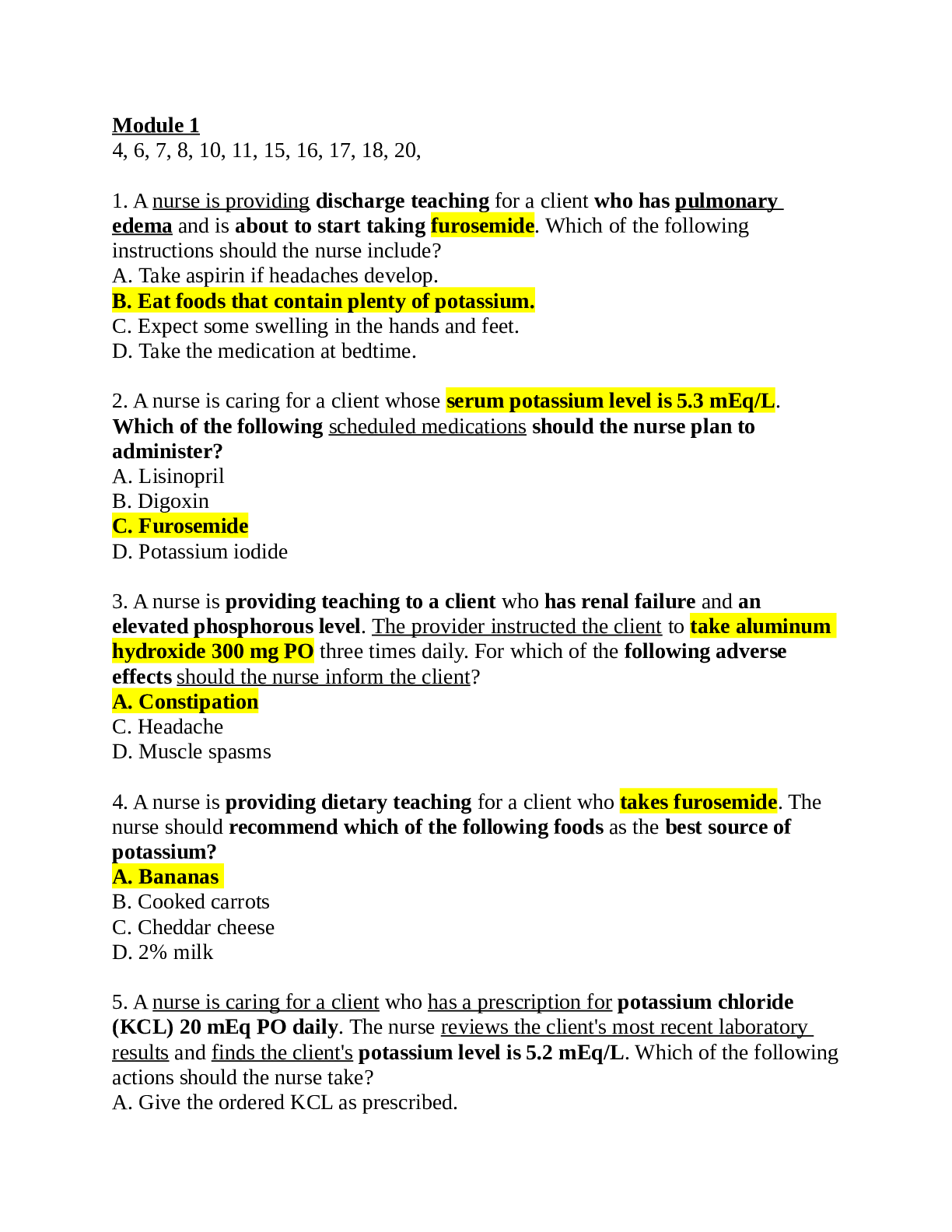
Reviews( 0 )
Document information
Connected school, study & course
About the document
Uploaded On
Apr 17, 2022
Number of pages
45
Written in
Additional information
This document has been written for:
Uploaded
Apr 17, 2022
Downloads
0
Views
49

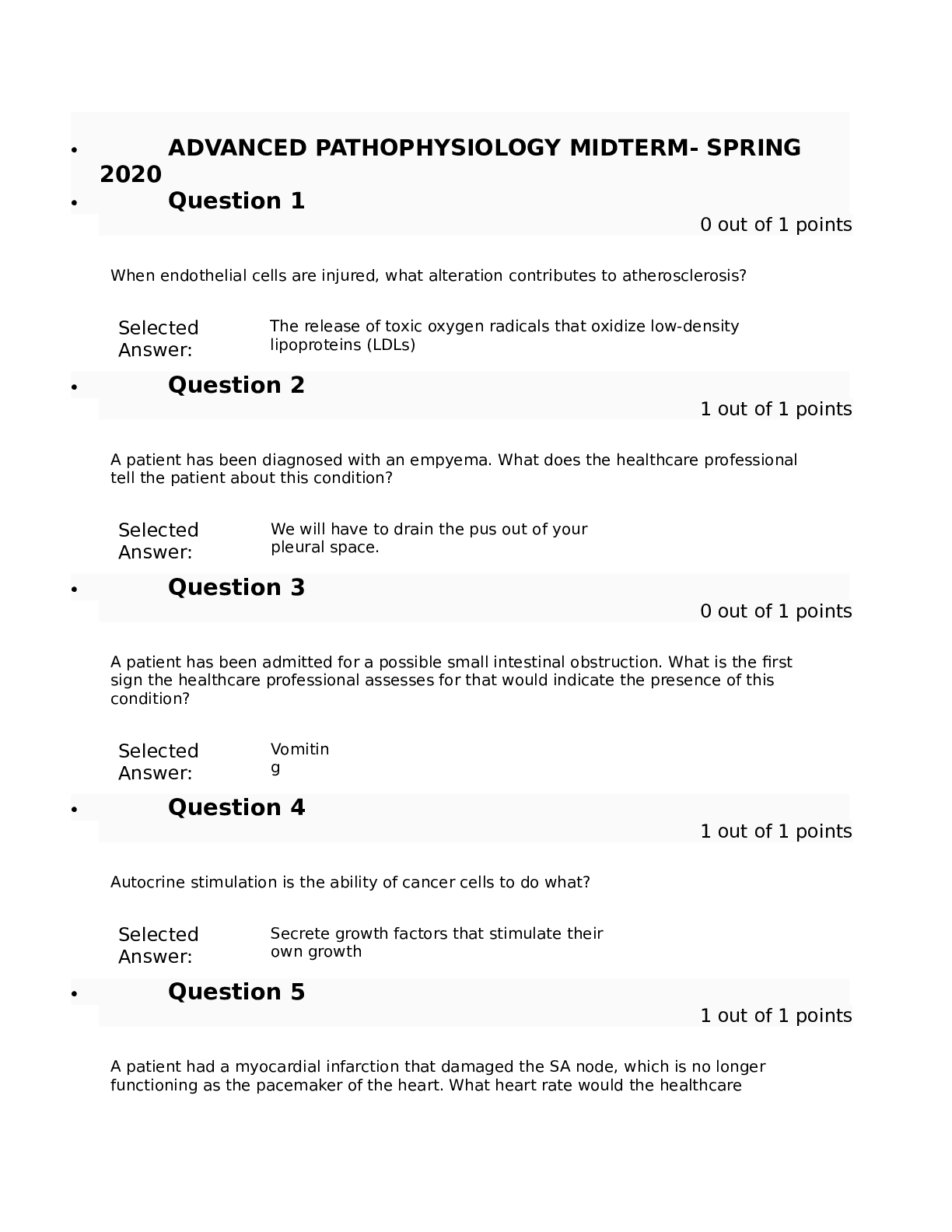



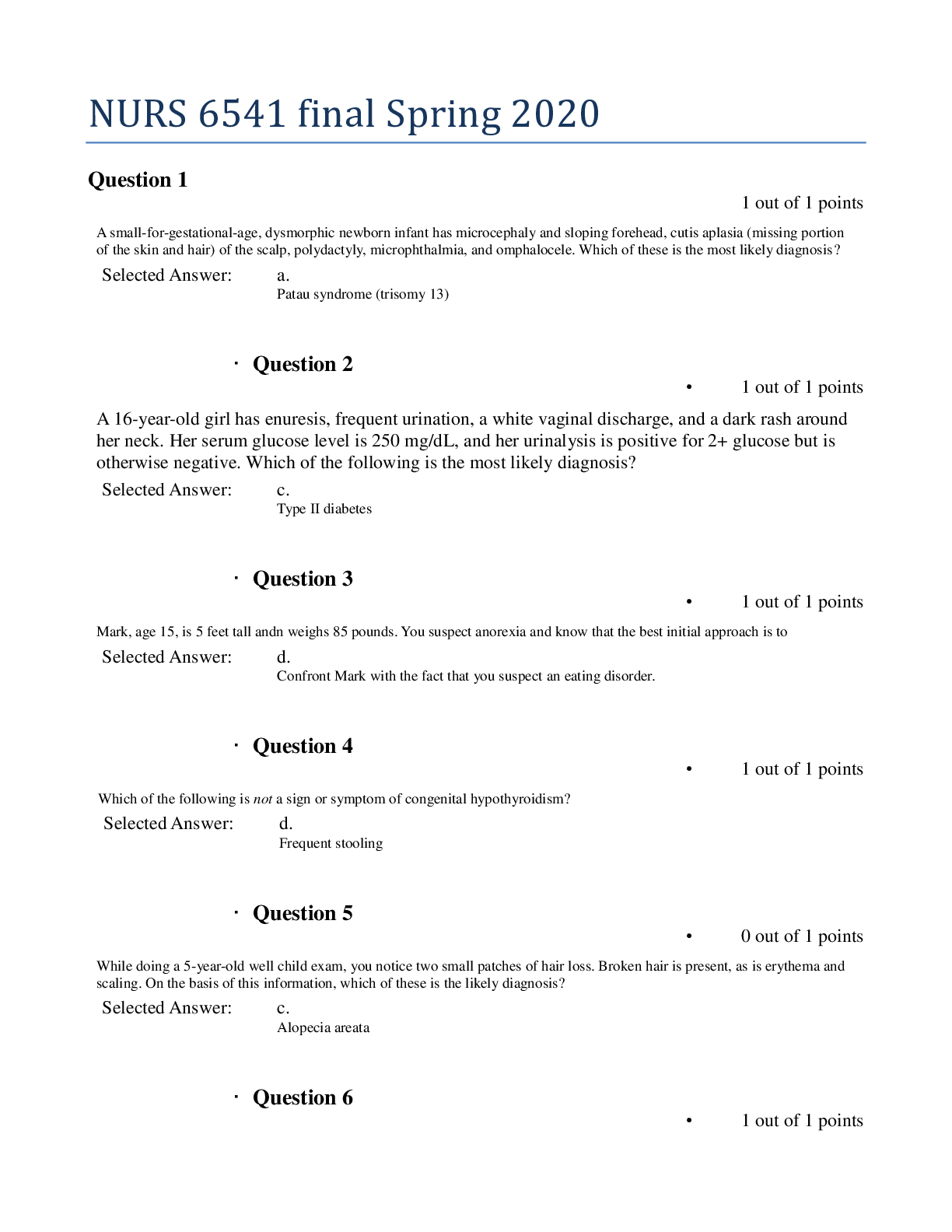
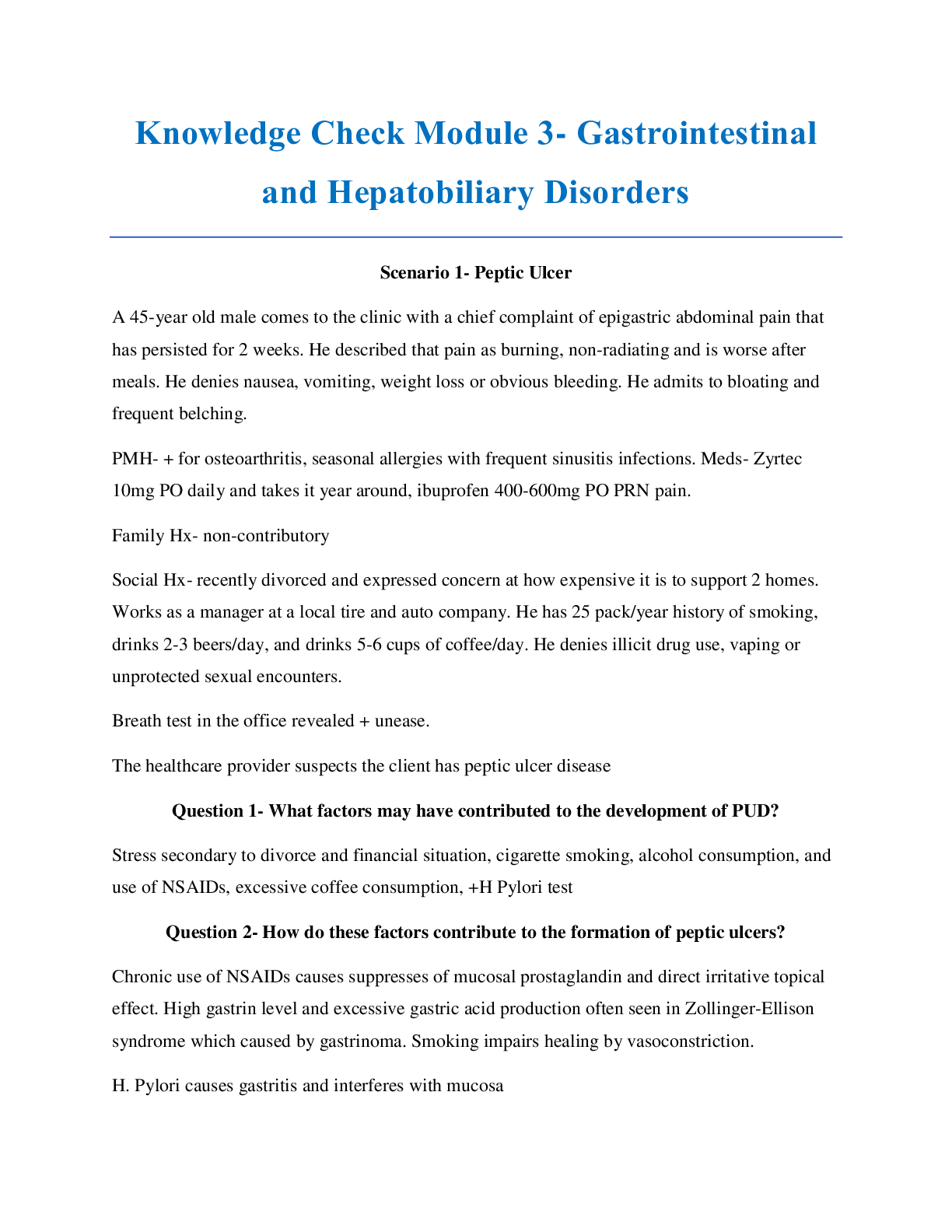

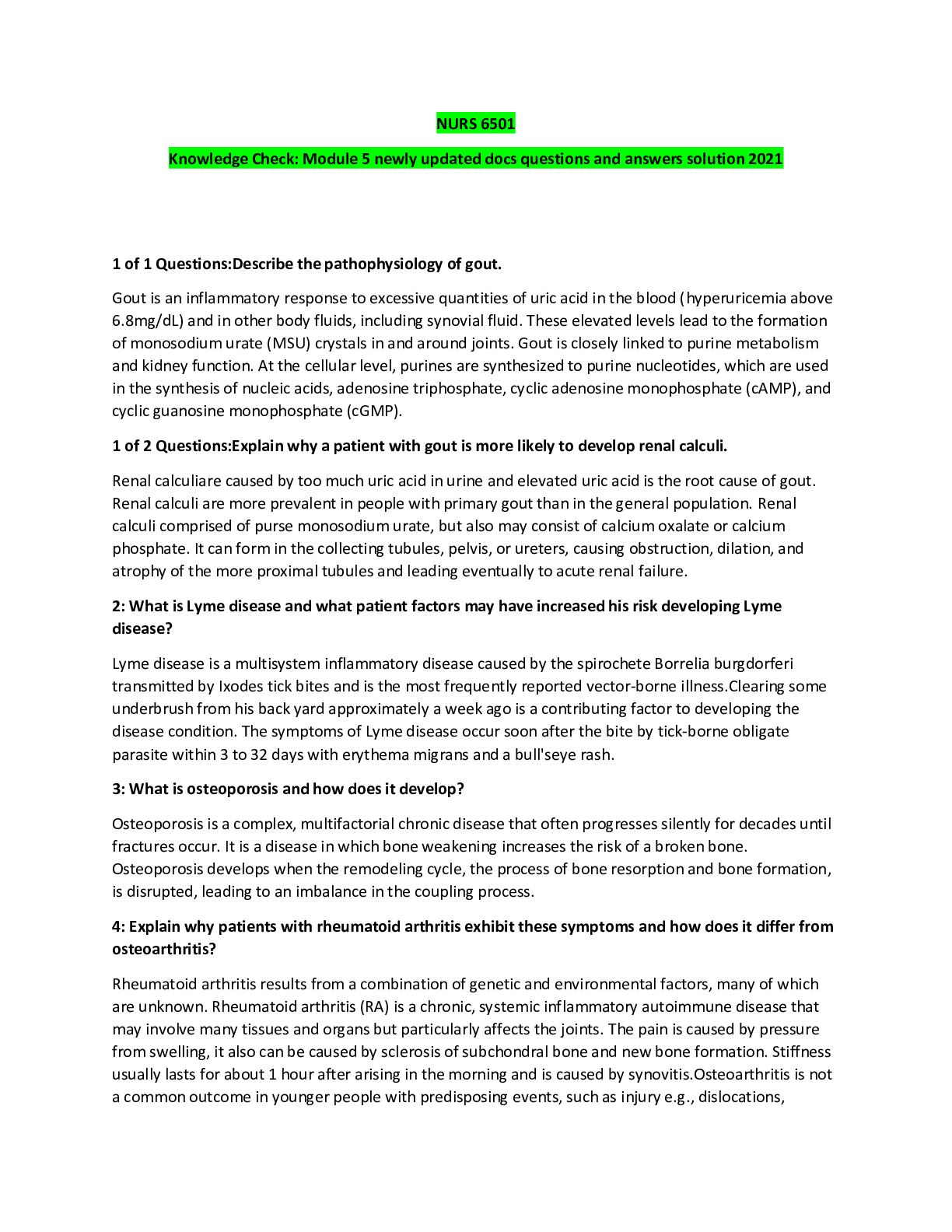
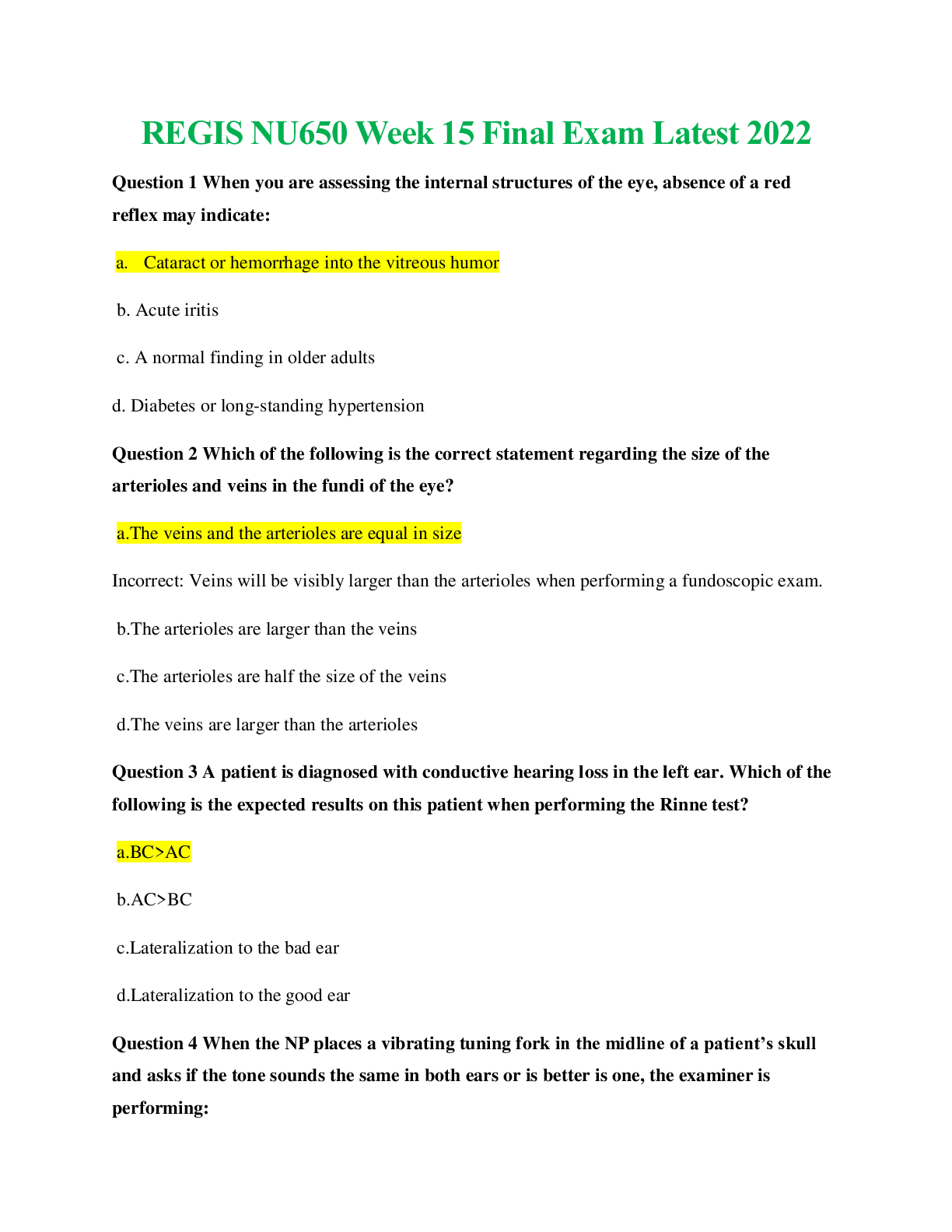
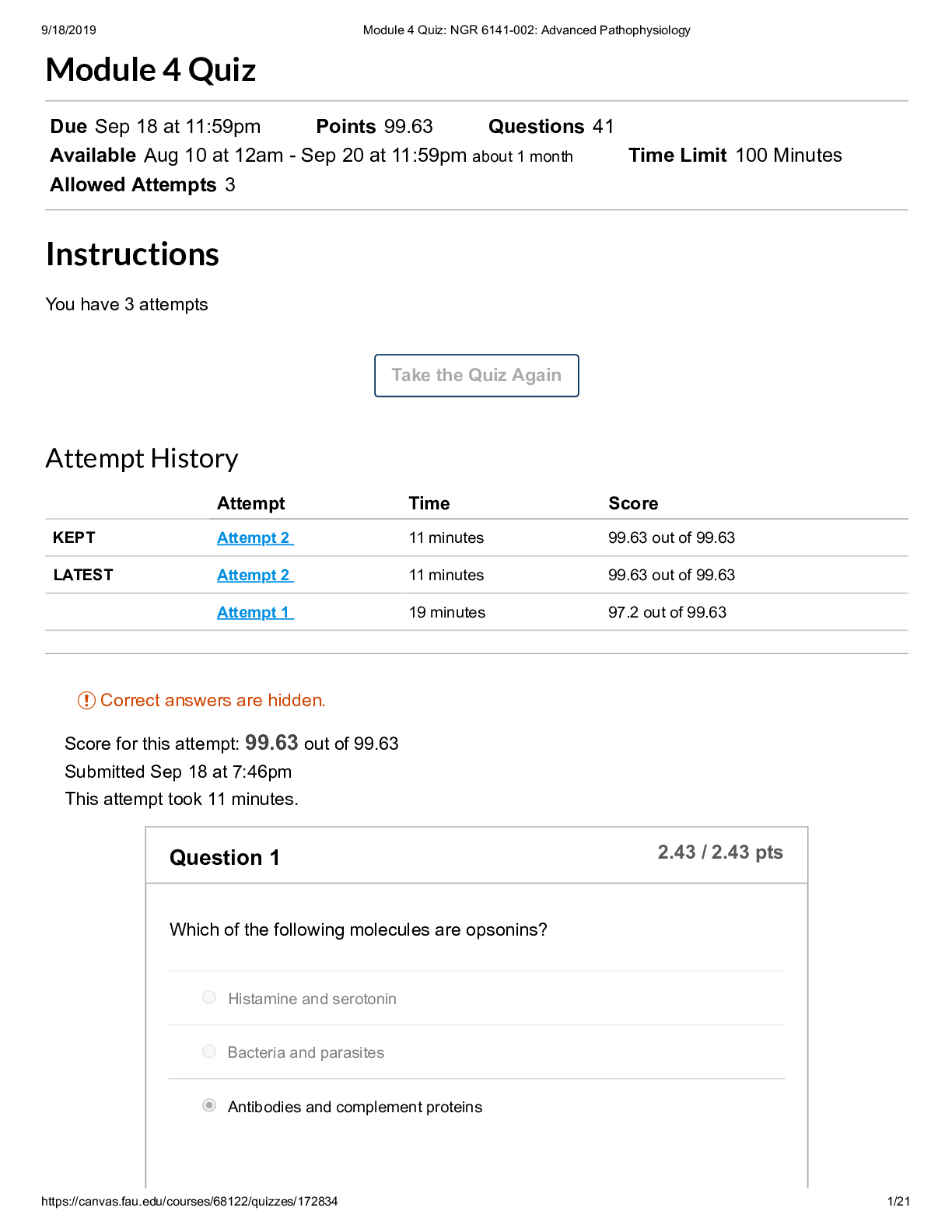
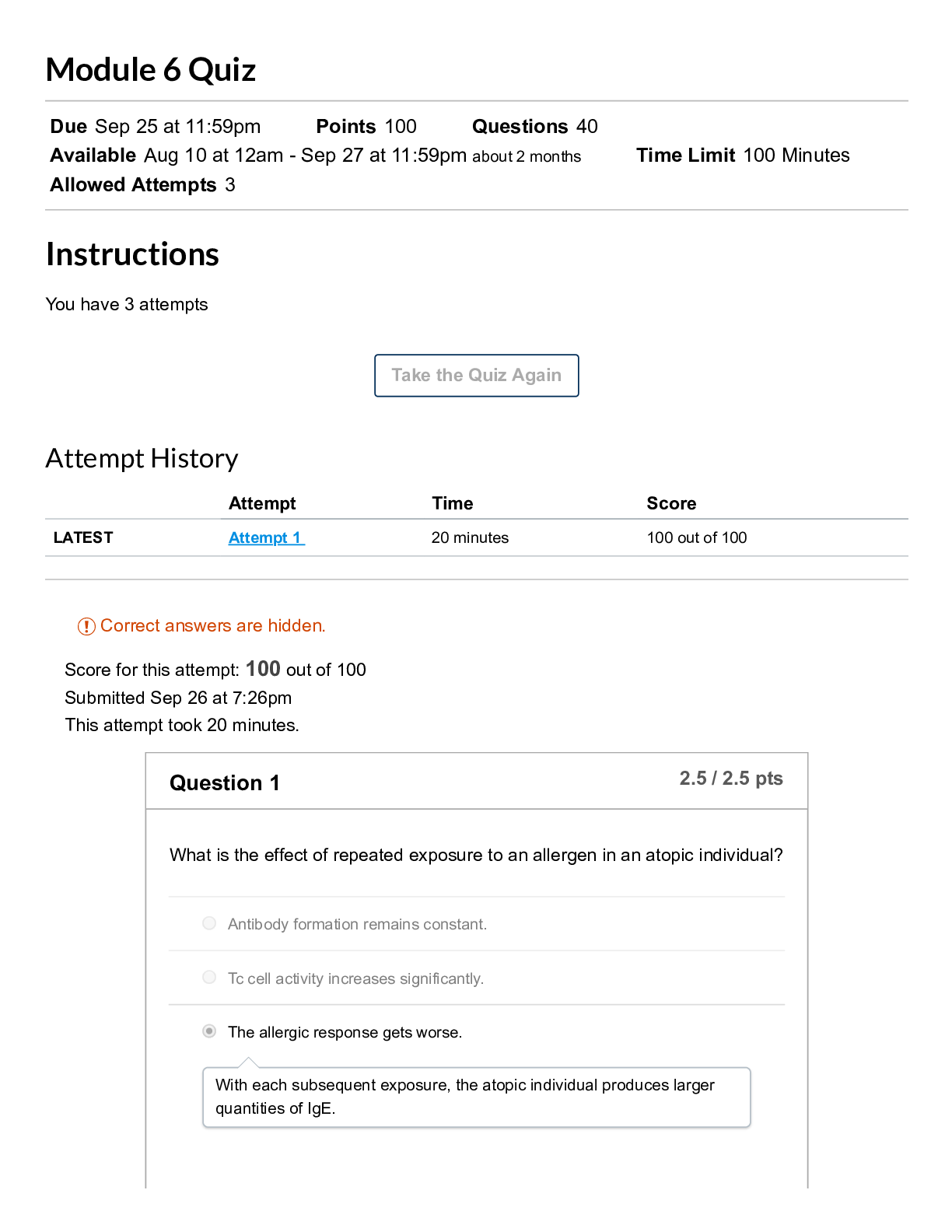
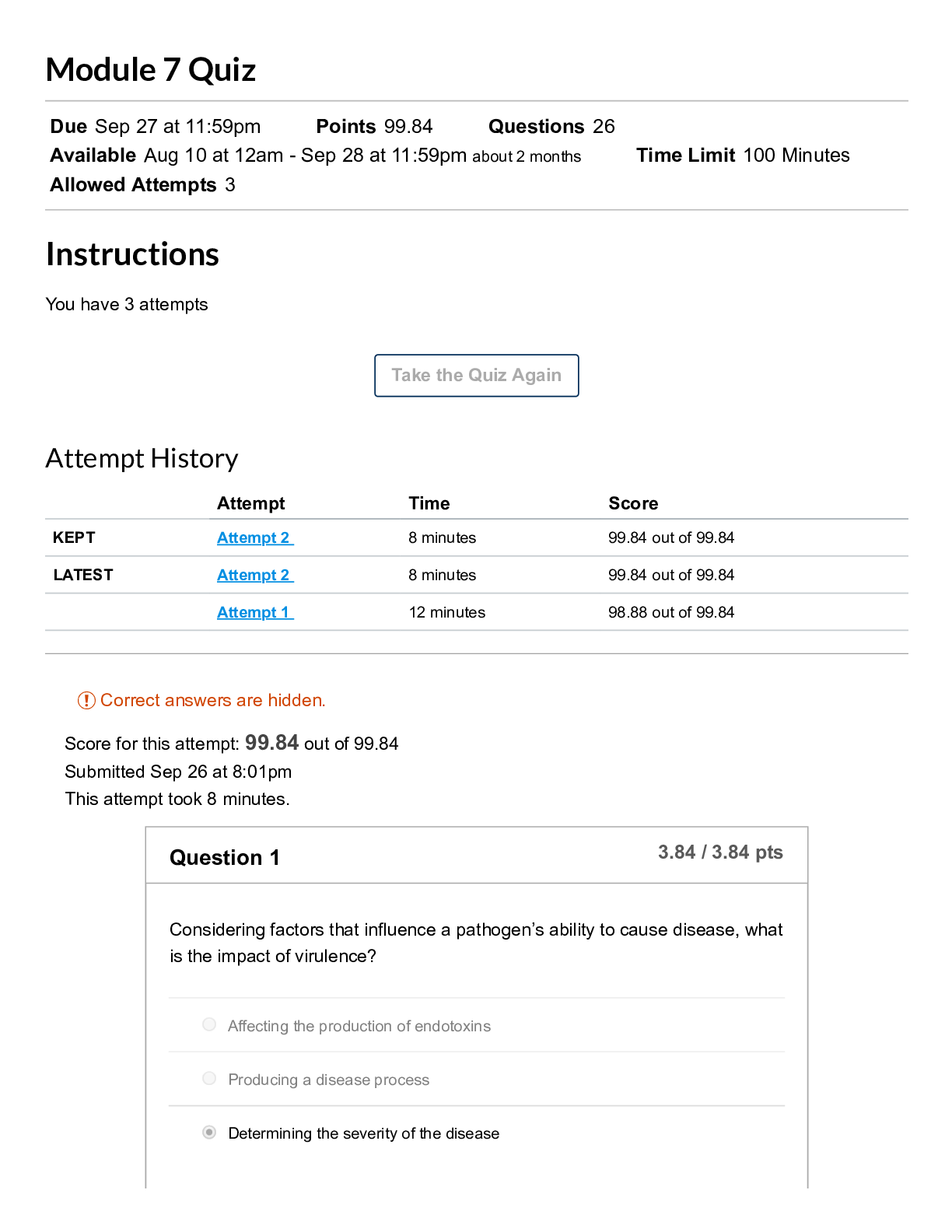
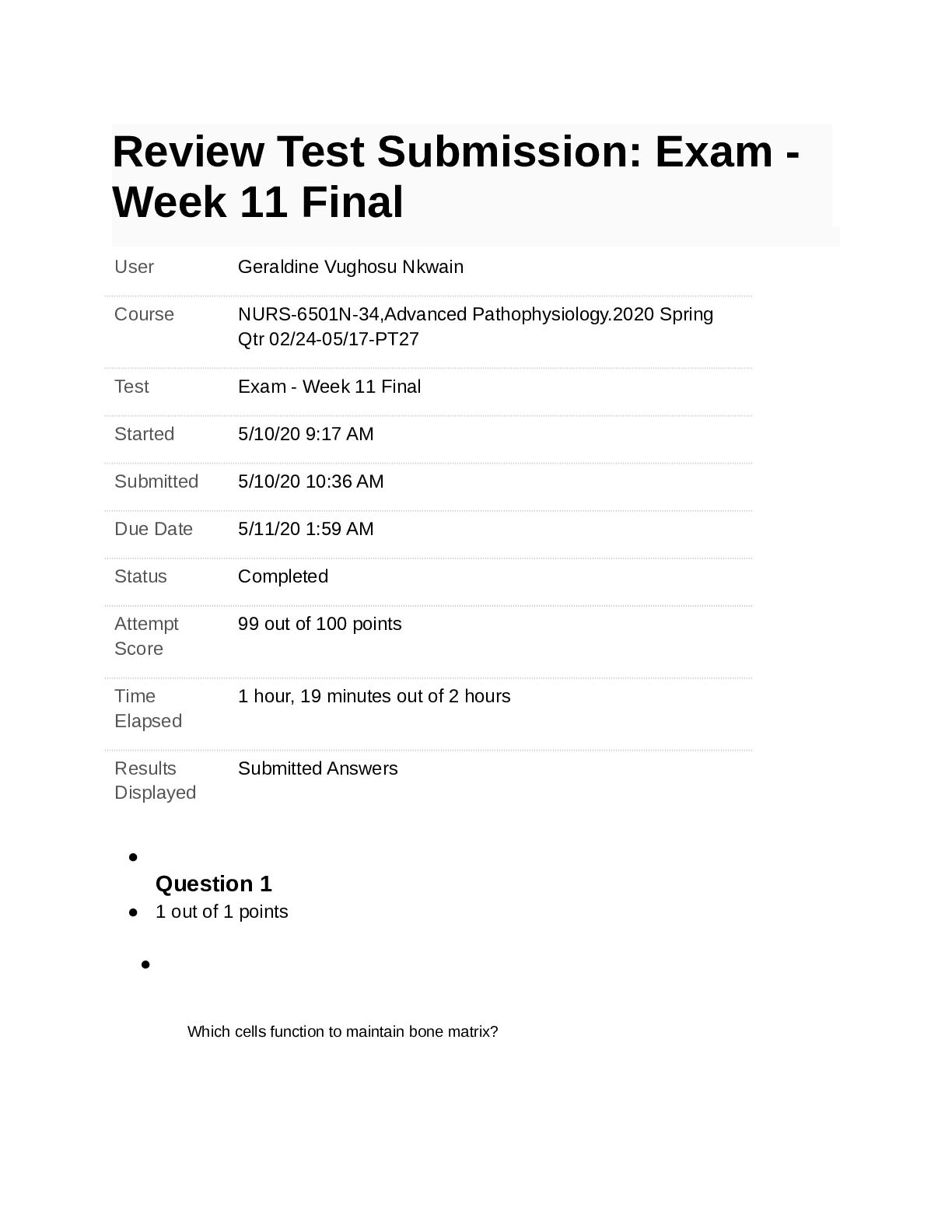
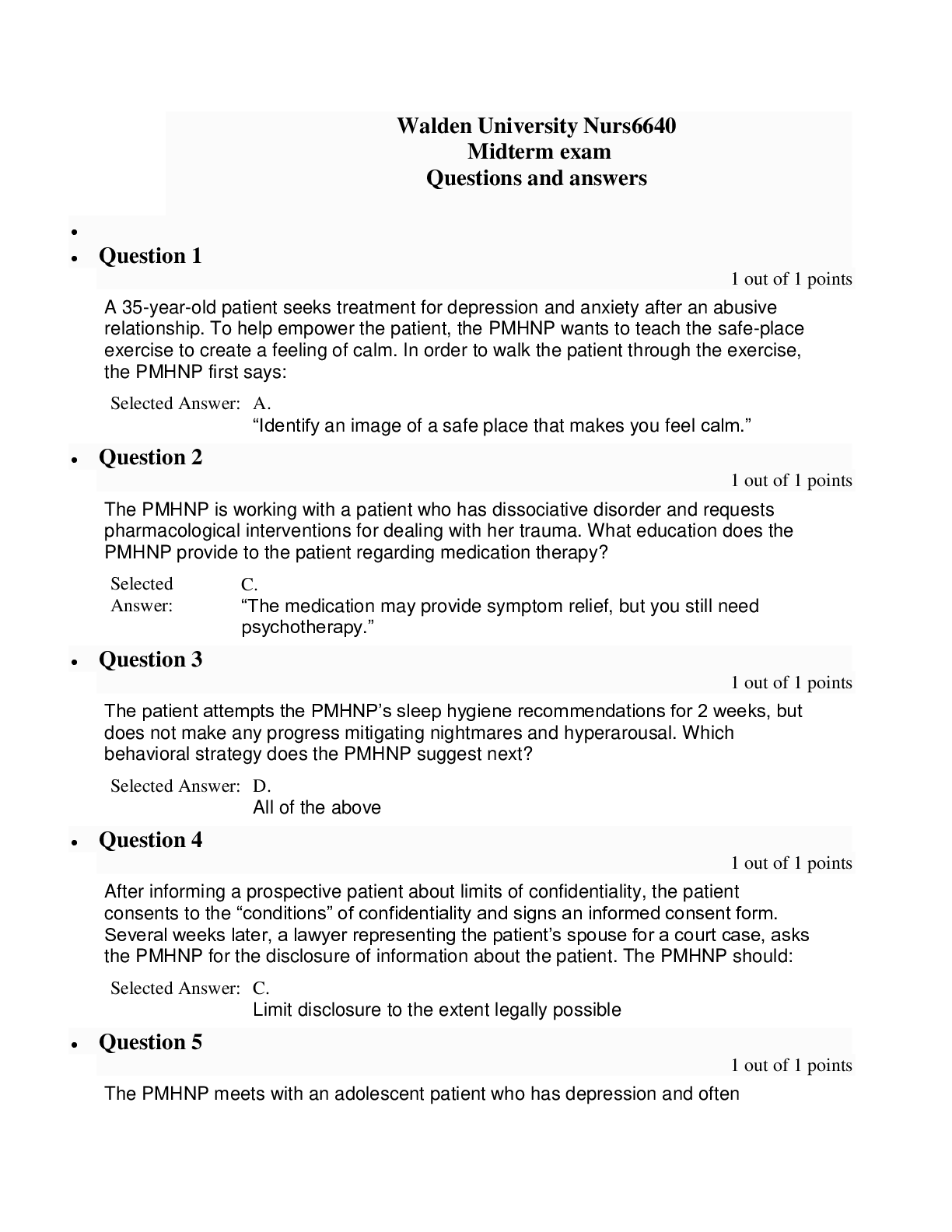
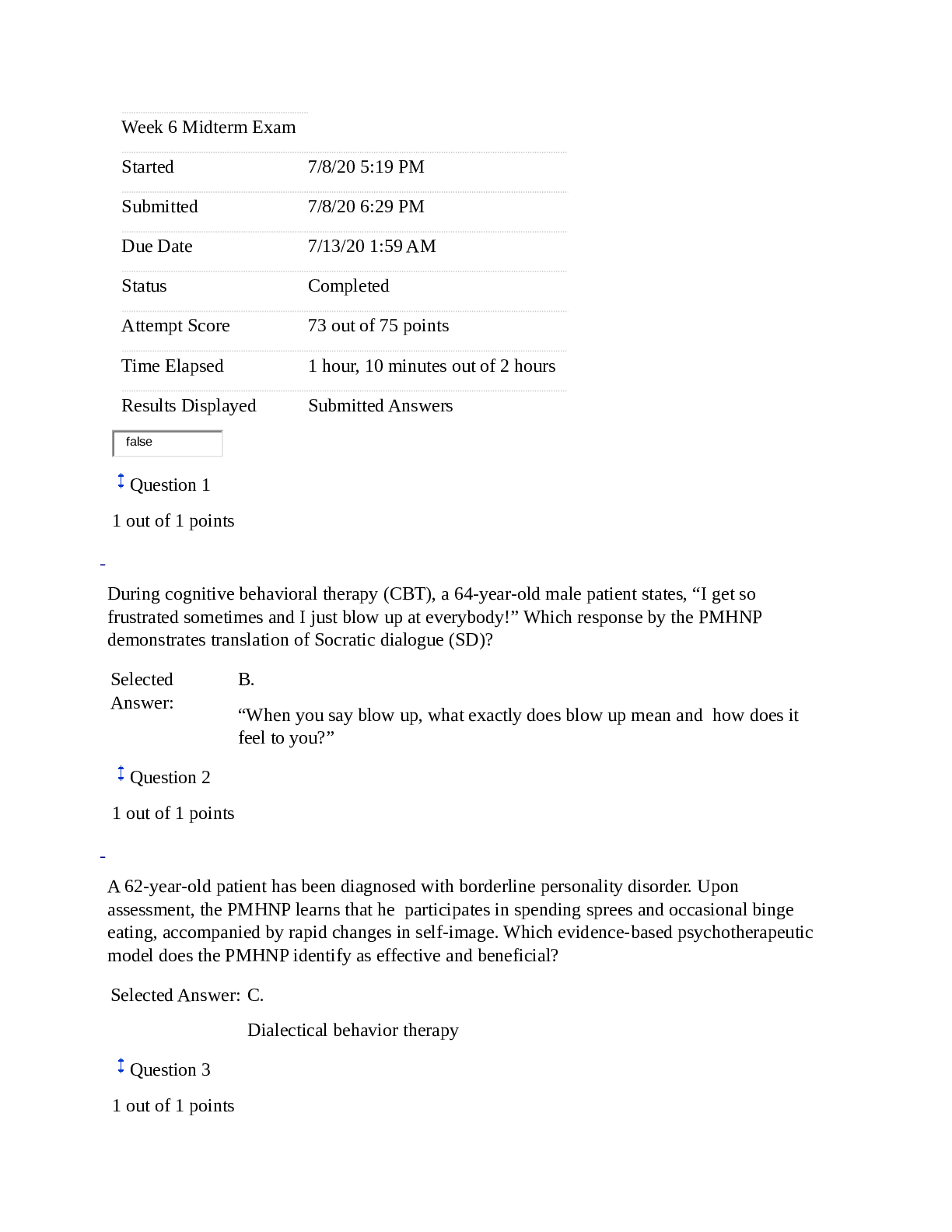
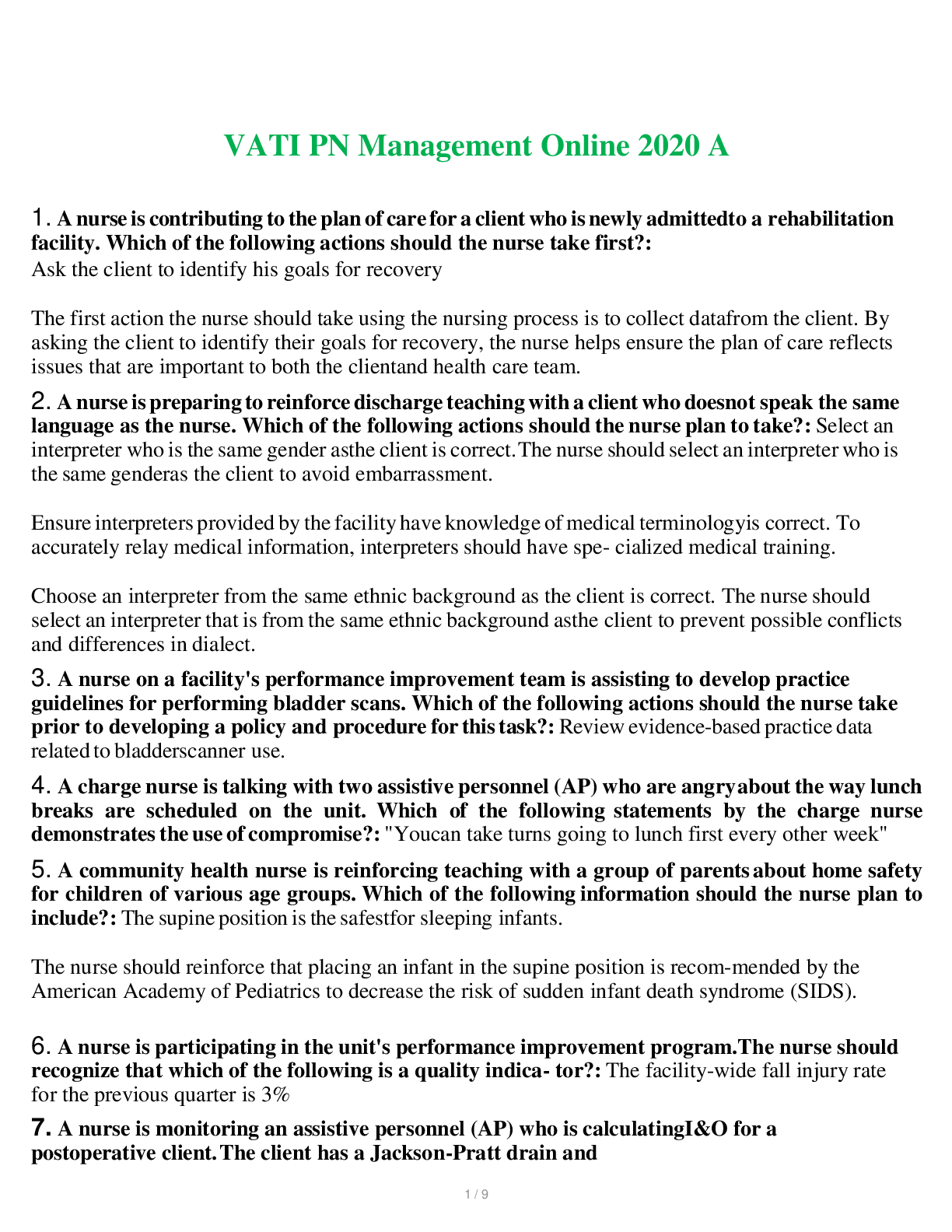
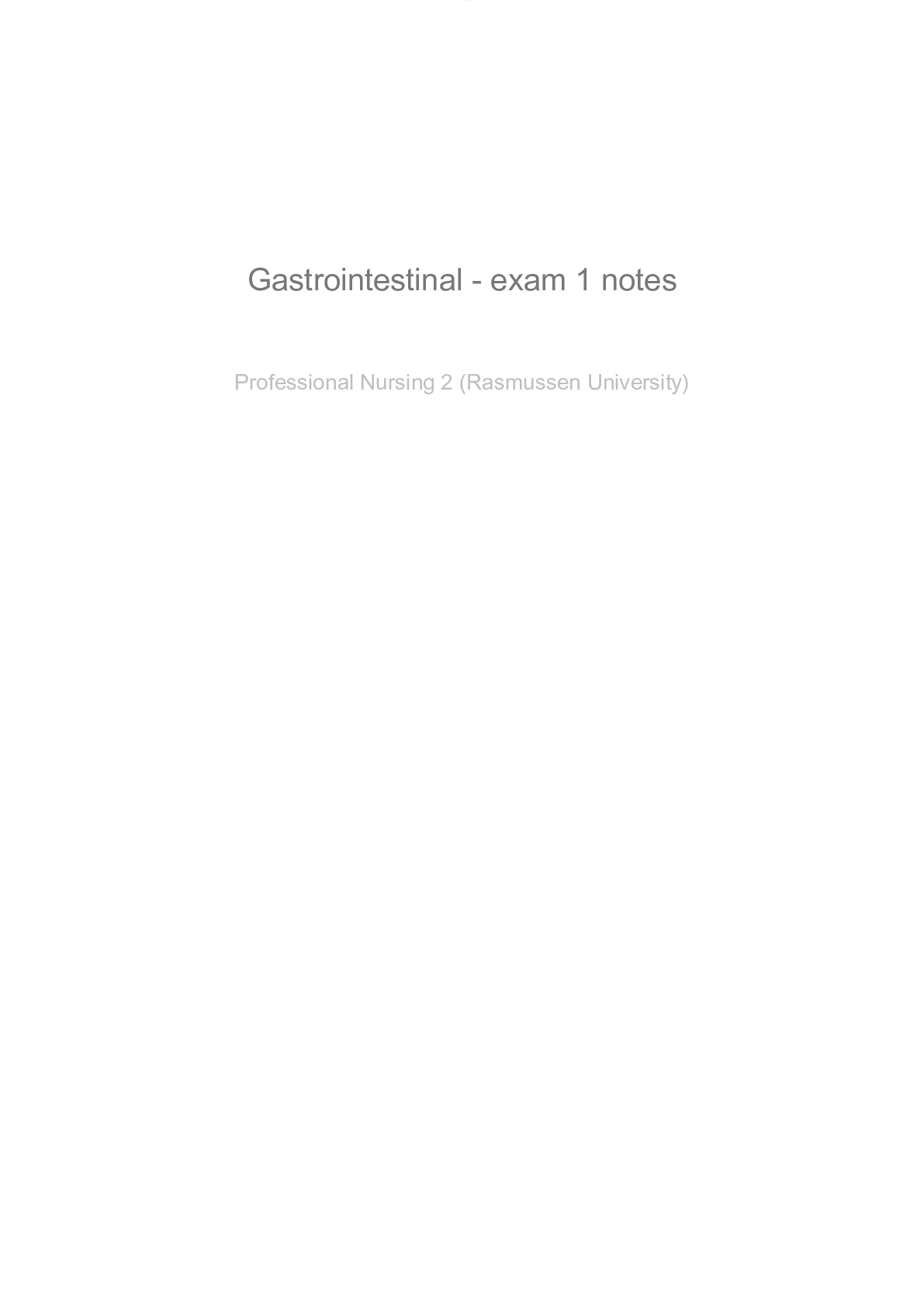
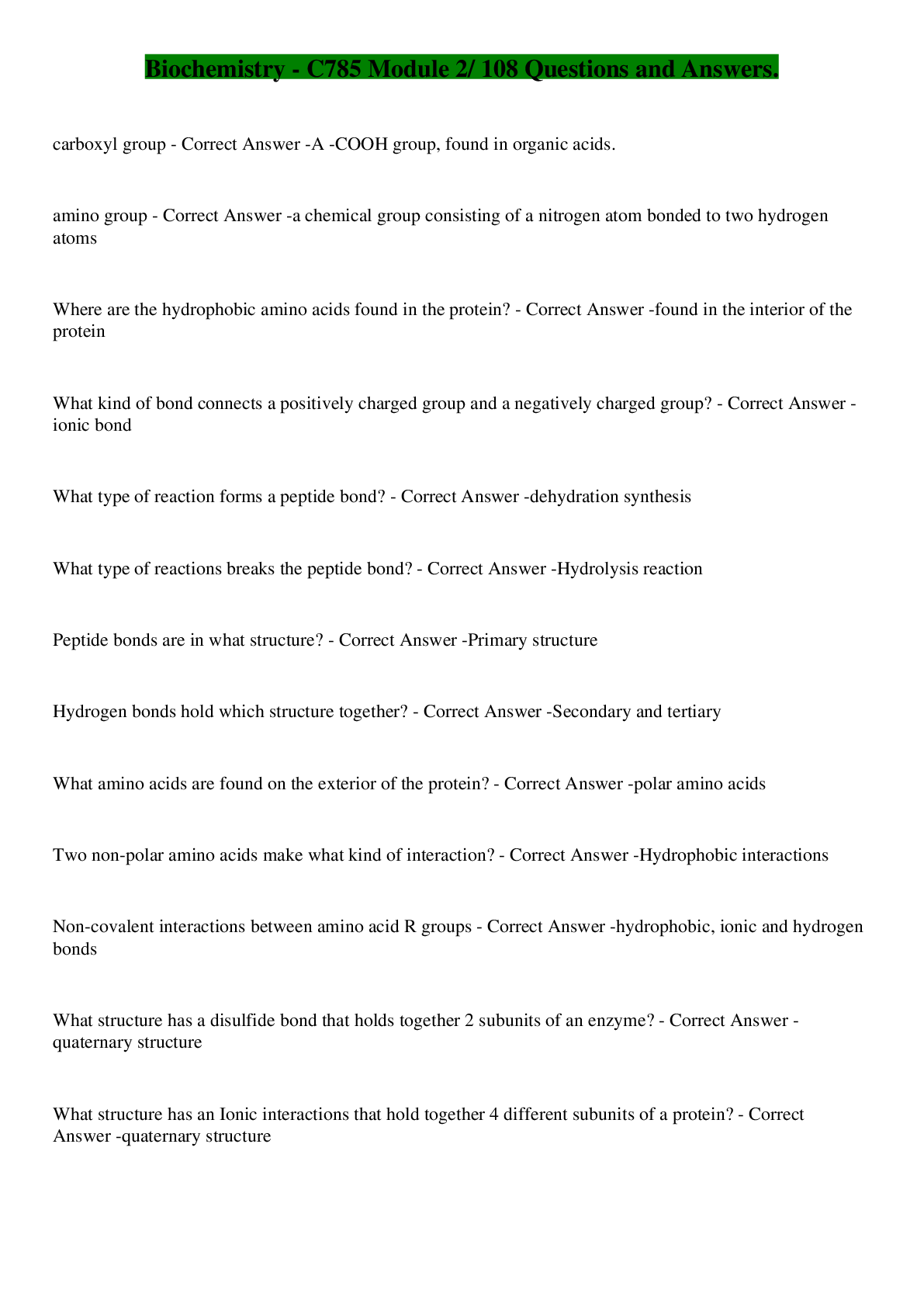

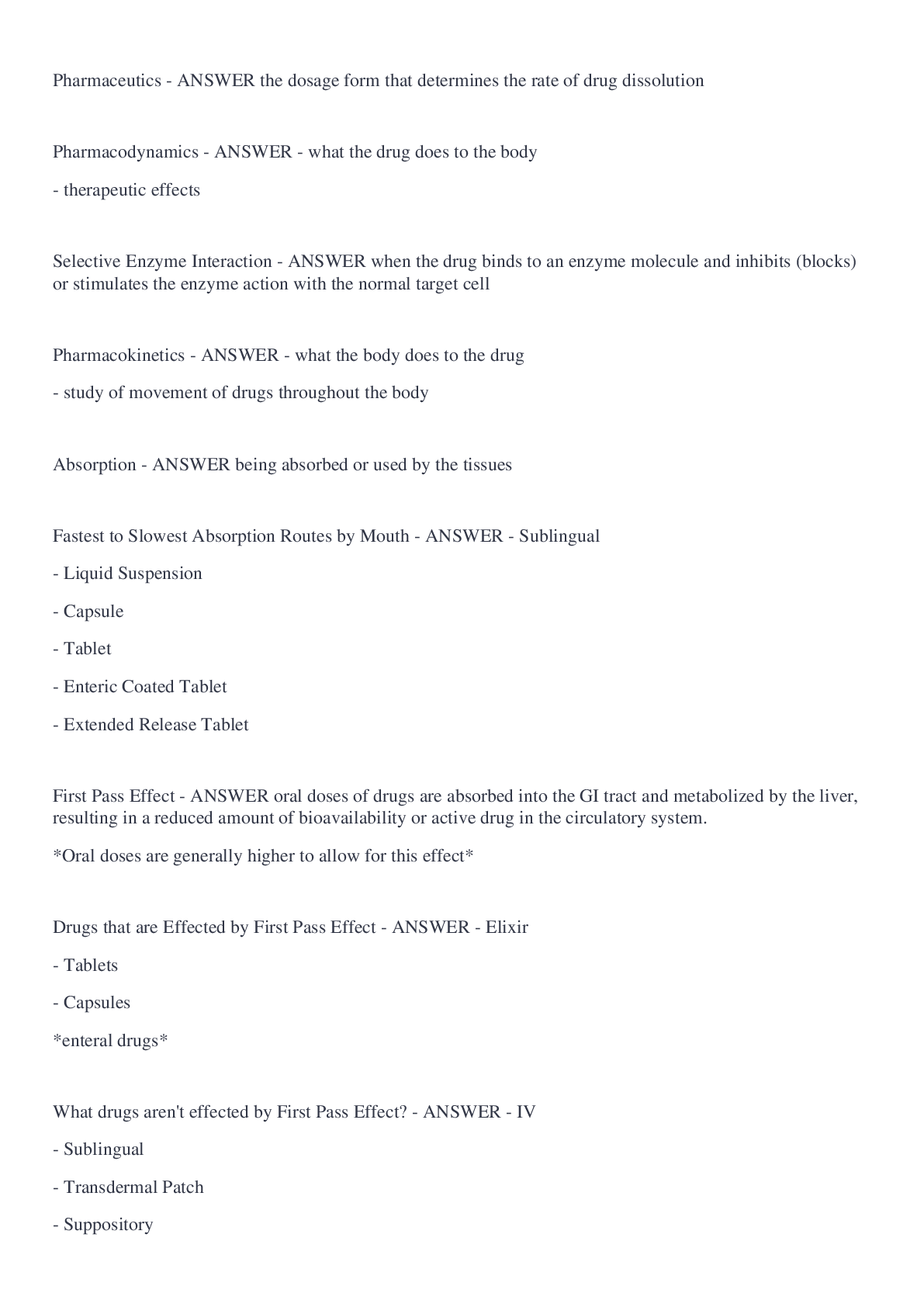

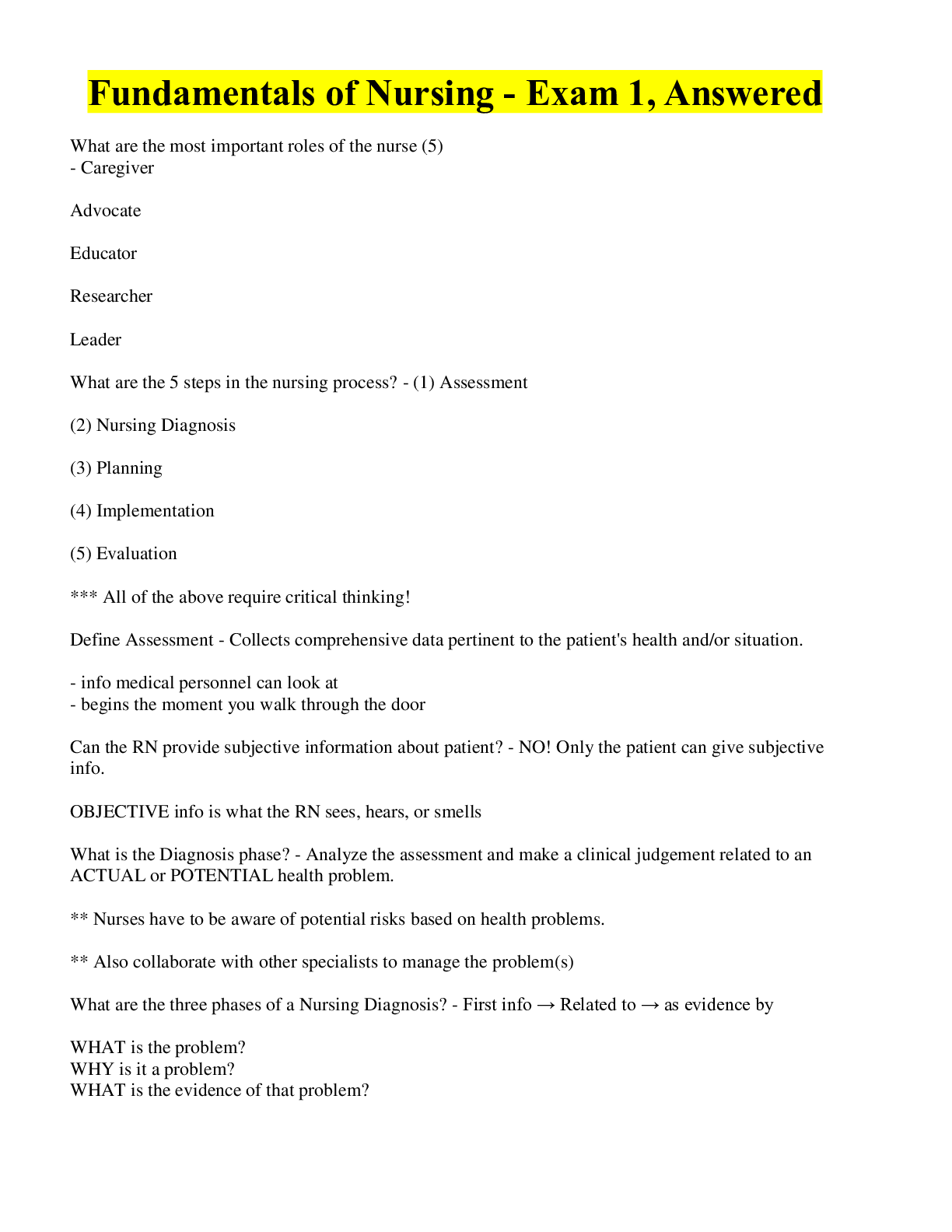

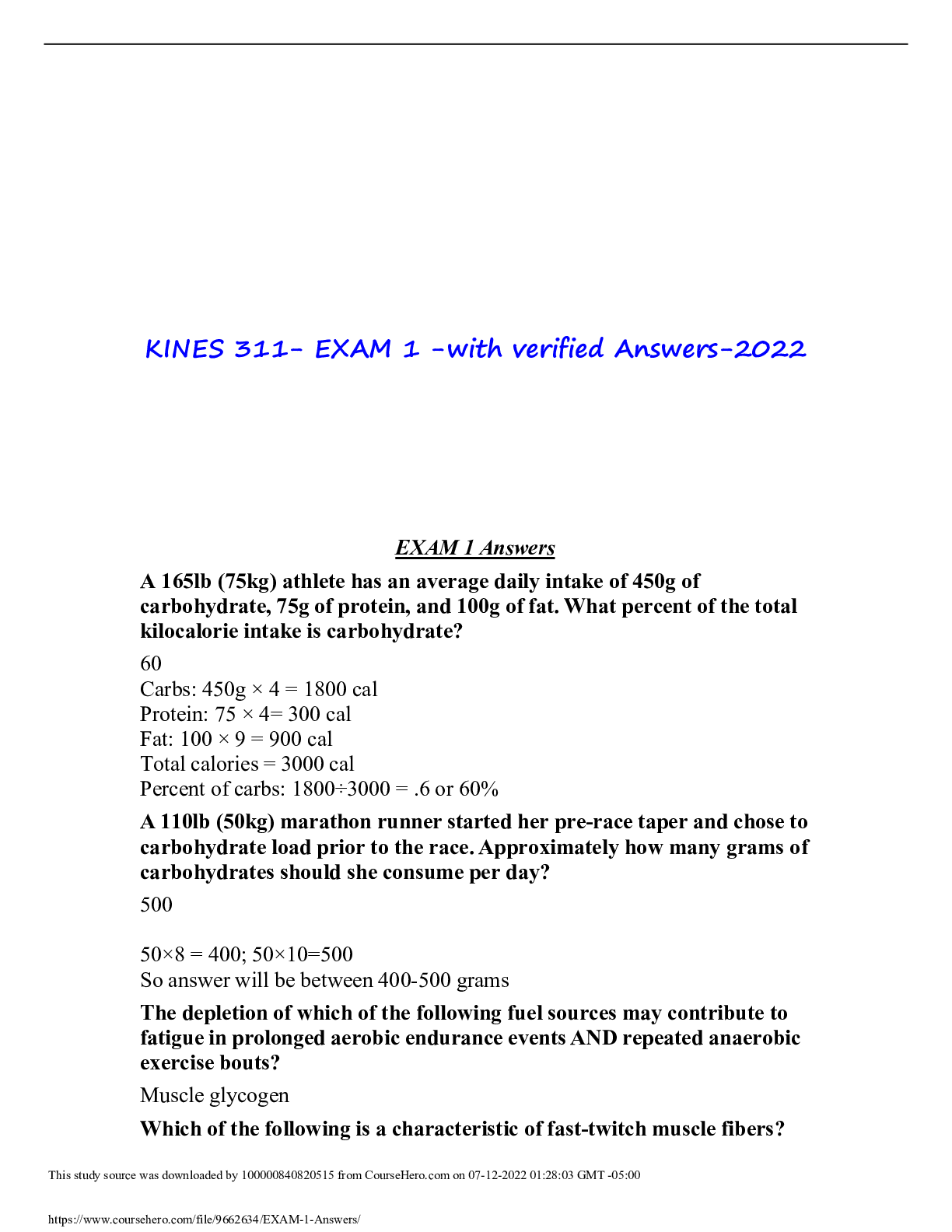
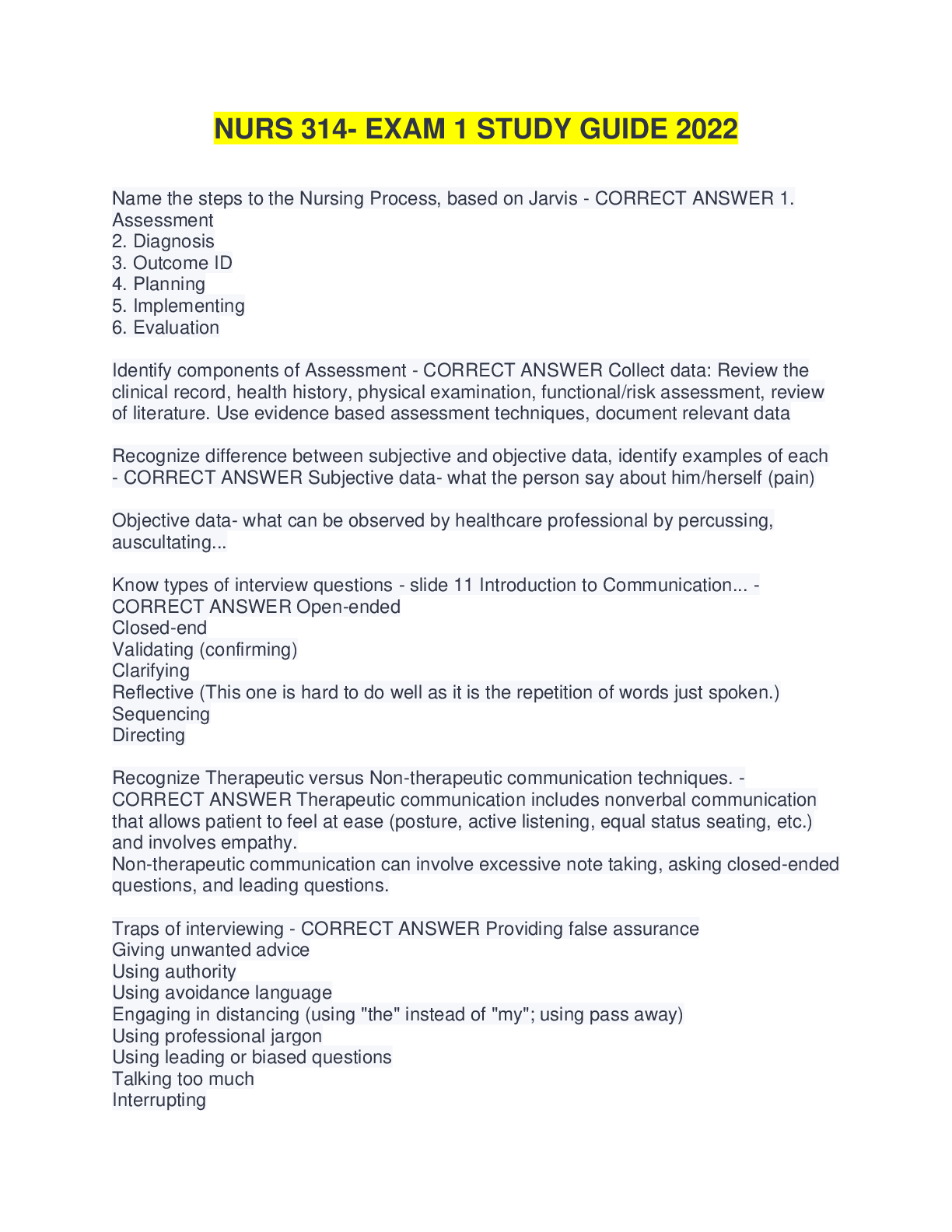
.png)
